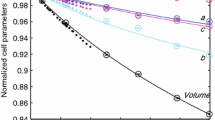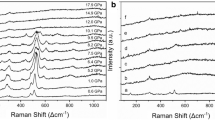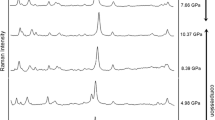Abstract
Raman vibrational spectra and X-ray diffractometer scans were obtained from experimentally shocked samples of oligoclase (An19) and andesine (An49). Some 11 oligoclase and 15 andesine targets were shocked between 24 and 40 GPa to address the transition from crystalline to diaplectic states and to explore differences in the structural state of diaplectic feldspar glasses (maskelynite) as a function of peak shock stress. Thy symmetrical VS (T-O-T) (T=Si or Al) stretch bands are the most persistent. They disappear, however, in the noise of an unusually strong luminescent spectrum at > 32 GPa in the oligoclase and at > 30 GPa in the andesine; i.e., at pressures where transition to diaplectic glass is complete. The Raman investigations yield a maskelynite structure that is probably one of a multitude of very small domains with some order, but with a large range of local properties on the scale of small domains, either in heterogeneous size-distribution of domains or in their detailed order, if not both. This results in a very large number of Raman photon-phonon frequencies unlike glasses derived from quenched melts. Our study corroborates conclusions by others, that diaplectic glasses may be the quench products of very dense, disordered phases that exist during shock compression and that subsequently relax to these unusually dense glasses that are only known from shock processes. An origin by relaxation of highly ordered, genuine high pressure polymorphs possessing the structure of hollandite is unlikely, as no evidence for any six-fold Si-coordination was found. Detailed luminescent emission spectra were taken of the oligoclase samples and they show disappearance of the IR band and a strengthening of the green band (the blue band could not be detected with a primary radiation of wavelength 448 nm). This supports previous views that the disappearance of IR emission is most likely caused by shock-induced changes of the crystal field near Fe3+ sites, rather than due to quenching by Fe2+. The X-ray studies were primarily intended to explore whether differences in structural states of maskelynite occur on sufficiently large scales to be detected by standard diffractometry methods. This is not the case. X-ray diffractometer patterns are grossly similar, if not identical, in samples shocked between 30 and 40 GPa and may not be used to fine-tune the shock histories of naturally produced diaplectic glasses.
Similar content being viewed by others
References
Ahrens TJ, Petersen CF, Rosenberg JT (1969) Shock compression of feldspars. J Geophys Res 74:2727–2746
Arndt J, Hummel W, Gonzalez-Cabeza I (1982) Diaplectic labradorite glass from the Manicouagan impact crater I: Physical properties, crystallization, structural and genetic implications. Phys Chem Minerals 8:230–239
Bunch TE, Cohen AJ, Dence MR (1967) Natural terrestrial maskelynite. Am Mineral 52:244–253
Bunch TE, Cohen AJ, Dence MR (1968) Shock-induced strutural disorder in plagioclase and quartz. In: French BM, Short NM (eds) Shock metamorphism of natural minerals. Mono Book Corp, Baltimore, pp 509–518
Diemann E, Arndt JL (1984) Diaplectic labradorite glass from the Manicouagan impact crater II: X-ray diffraction studies and structural model. Phys Chem Minerals 11:178–181
Duke MB (1968) The Shergotty meteorite: Magmatic and shock metamorphic features. In: French BM, Short NM (eds) Shock metamorphism of natural minerals. Mono Book Corp, Baltimore, pp 613–621
Duvall GE, Fowles GR (1963) Shock waves. In: Bradley RS (ed) High pressure physics and chemistry, vol 2. McGraw-Hill, New York, pp 209–291
Dworak U (1969) Stosswellenmetamorphose des Anorthosits von Manicouagan Krater, Quebec, Canada. Contrib Mineral Petrol 24:306–347
Engelhardt Wv, Stöffler D (1968) Stages of shock metamorphism in crystalline rocks of the Ries Basin, Germany. In: French BM, Short NM (eds) Shock metamorphism of natural materials. Mono Book Corp, Baltimore, pp 159–168
Estep PA, Kovack JJ, Waldstein P, Karr Jr C (1972) Infrared and Raman spectroscopic studies of structural variations in minerals from Apollo 11, 12, 14, and 15 samples. Proc 3rd Lunar Sci Conf, MIT Press, Cambridge, pp 3047–3067
Fabel GW, White WB, White EW, Roy R (1972) Structure of lunar glasses by Raman and soft x-ray spectrography. Proc 3rd Lunar Sci Conf, MIT Press, Cambridge, pp 939–951
French BM, Short NM (eds) (1968) Shock metamorphism of natural materials. Mono Book Corp, Baltimore
Geake JE, Walker G (1975) Luminescence of minerals in the near-infrared. In: Karr Jr C (ed) Infrared and raman spectroscopy of lunar and terrestrial minerals. Academic Press, New York, pp 73–89
Geake JE, Walker G, Mills AA, Garlick GFJ (1971) Luminescence of Apollo lunar samples. Proc 2nd Lunar Sci Conf, MIT Press, Cambridge, pp 2265–2275
Geake JE, Walker F, Telfer DJ, Mills AA, Garlick GFJ (1973) Luminescence of lunar, terrestrial, and synthesized plagioclase, caused by Mn2+ and Fe3+. Proc 4th Lunar Sci Conf, pp 3181–3189
Gibbons RV, Ahrens TJ (1977) Effects of shock pressure on calcic plagioclase. Phys Chem Minerals 1:95–107
Grady DE (1980) Shock deformation of brittle solids. J Geophys Res 85:913–924
Hanss RE, Montague BR, Davis MK, Galindo C, Hörz F (1977) X-ray diffractometer studies of shocked materials. Proc 9th Lunar Planet Sci Conf, pp 2773–2787
Hörz F (1970) A small ballistic range for impact metamorphism studies. NASA Technical Note D-5787:15
Hörz F, Quaide WL (1973) Debye-Scherrer investigations of experimentally shocked silicates. The Moon 6:45–72
Hörz F, Hanss R, Serna C (1986) X-ray investigations of the shock history of the Shergottite achondrite. Geochim Cosmochim Acta 50:905–908
Lal JC (1986) The Shergotty consortium and SNC meteorities: an overview. Geochim Cosmochim Acta 50:875–889
Lambert P, Grieve RAF (1984) Shock experiments on maskelynite-bearing anorthosite. Earth Planet Sci Lett 68:159–171
Marsh SP (ed) (1980) LASL Shock Hugoniot Data, University of California Press, p 658
McMillan P, Piriou N, Navrotsky A (1982) A Raman spectroscopic study of glasses along the joint silica-calcium aluminate, silica-sodium aluminate and silica-potassium aluminate. Geochim Cosmochim Acta 46:2021–3047
Milton DJ, DeCarli PS (1963) Maskelynite: Formation by explosive shock. Science 140:670–671
Ostertag R (1983) Shock experiments on feldspar crystals. Proc 14th Lunar Planet Sci Conf, Supp J Geophys Res: B365–B367
Sharma SK, Virgo D, Mysen B (1978) Structure of melts along the joint SiO2-NaAlSiO4. Carnegie Inst Wash Yearb 77:652–658
Sharma SK, Simons B, Yoder Jr HS (1983) Raman study of anorthite, calcium-Tschermak's pyroxene and gehlenite in crystalline, and glassy states. Am Mineral 68:1113–1125
Sharma SK, Philpotts JA, Matson DW (1985) Ring distribubtions in alkali-and alkaline-earth alumino-silicate framework glasses — a Raman spectroscopic study. J Noncryst Solids 71:403–410
Sippel RF, Spencer AB (1970) Luminescence petrography and properties of lunar crystalline rocks and breccias. Proc Apollo 11 Lunar Sci Conf, MIT Press, Cambridge, pp 2413–2426
Smith JV (1974) Feldspar minerals, vols I and II. Springer, Berlin Heidelberg New York
Stöffler D (1972) Deformation and transformation of rock-forming minerals by natural and experimental shock processes I: Behavior of minerals under shock compressions. Fortschr Mineral 49:50–113
Stöffler D (1974) Deformation and transformation of rock-forming minerals by natural and experimental shock processes II: Physical properties of minerals. Fortschr Mineral 51:256–289
Stöffler D (1984) Glasses formed by hypervelocity impact. J Non-cryst Solids 67:465–502
Stöffler D, Hornemann U (1972) Quartz and feldspar glasses produced by natural and experimental shock. Meteorities 78:371–394
Stöffler D, Ostertag R, Jammes C, Pfannschmidt G, SenGupta PR, Simon SB, Papike JJ, Beauchamp RU (1986) Shock metamorphism and petrography of the Shergotty achondrite. Geochim Cosmochim Acta 50:889–908
Tschermak G (1872) Die Meteoriten von Shergotty and Gopalpur. Sitzunsber. Akad Wiss Wien Math-Naturwiss K 65 Part 1:122–146
Tyburzy TA, Ahrens TJ (1986) Dynamic compression and volatile release of carbonates. J Geophys Res 91:4730–4744
Velde B, Boyer H (1986) Raman microprobe spectra of shocked plagioclase feldspars. Raman Spectrosc Earth Sci Init Appl Georaman 86:23–24
Virgo D, Mysen BO, Siefert F (1979) Structures of quenched melts in the system NaAl AlO4-CaMgSi2O6-Mg2SiO4-SiO2 at 1 atm. Carnegie Inst Wash Yearb 78:502–506
Author information
Authors and Affiliations
Rights and permissions
About this article
Cite this article
Heymann, D., Hörz, F. Raman-spectroscopy and X-ray diffractometer studies of experimentally produced diaplectic feldspar glass. Phys Chem Minerals 17, 38–44 (1990). https://doi.org/10.1007/BF00209224
Received:
Issue Date:
DOI: https://doi.org/10.1007/BF00209224




